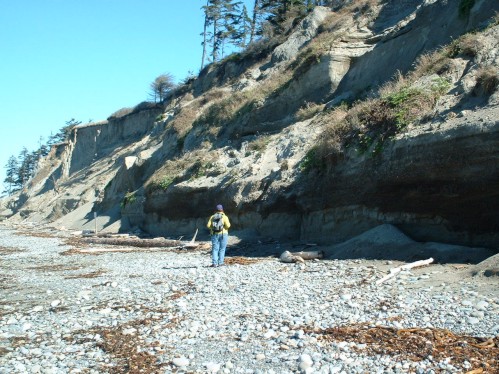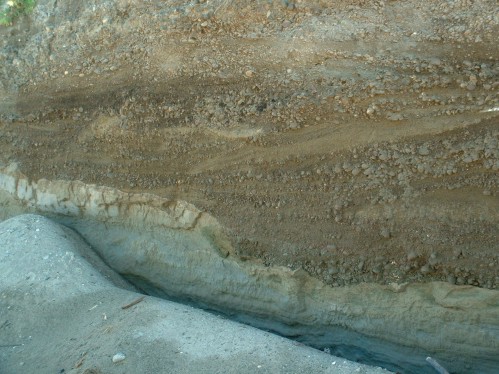UPDATE: Last picture link fixed.
The second part of the trip went from a place called Ruby Beach, which I blogged about somewhere else at one time. There are far better photos here, but I have one geological photo:

Not about 2/3 of the way up that formation there is a line where the overlying glacial till contacts the underlying bedrock. These are very common deposits around western Washington, though I have only seen the upper portions of them; never where they come in contact with the basement rocks. More on this later.
Next was Sequim.
Sequim has a small museum with an exhibit devoted to the Manis Mastodon site. This is a fairly famous site for early North Americanists because it is one of the earliest associations of extinct Pleistocene megafauna with undoubted human artifacts (ca. 12,000 BP). The Museum and Art Center in Sequim has a few pictures of the exhibit here; I went to have a look but forgot my camera. There are also a few photos here.
The exhibit itself is not bad. On thing I did notice was in one explanatory card they stated unequivocally that the mastodonts were killed off by climate change. Obviously done up before Paul Martin started publishing! Or maybe after and whoever did it just didn't buy into Overkill.
The beach by Dungeness Spit contains some more of the till deposits noted above:

This shows some of the strata apparent within the till. The dark layer seen in that photo looks like this close up:

You can see it's got its own internal stratification, but overall is much coarser than the underlying deposits. The dark color is probably because it contains more water; the stuff underneath is much finer. That underlying junk is mostly compact silt, but I found some portions that ere a very hard, fine clay. I have been told that much of this clay, at least that found within the Puget Sound proper, was used extensively for pottery manufacture in the area.
Finally,

this shows some of the beach gravel, most of which presumably derives from the till. Note the wide variety of sizes and different materials present, all part of the junk the glaciers carried down from Canada and Alaska.